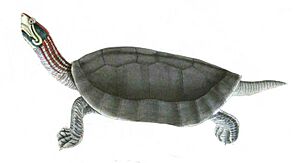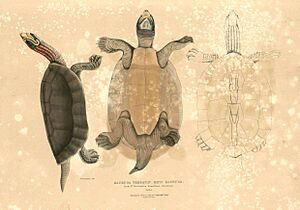Red-crowned roofed turtle facts for kids
Quick facts for kids Red-crowned roofed turtle |
|
|---|---|
 |
|
| Batagur kachuga Illustration based on Francis Buchanan-Hamilton's drawing (1832) |
|
| Conservation status | |
| Scientific classification | |
| Genus: |
Batagur
|
| Species: |
kachuga
|
| Synonyms | |
|
|
The red-crowned roofed turtle (Batagur kachuga) is a special kind of turtle that lives only in freshwater in South Asia. It's also called the Bengal roof turtle.
These turtles love to warm up in the sun on land. When it's time to find a mate, the male turtles get very colorful. Their heads and necks turn bright red, yellow, and blue! Female turtles dig nests and lay up to thirty eggs at a time.
Sadly, this turtle is in big trouble. There are fewer than 400 adult females left in the wild. This is why the International Union for Conservation of Nature says this turtle is "critically endangered". This means it's very close to disappearing forever. People are working hard to protect them and help them have more babies.
Contents
What Does the Red-Crowned Roofed Turtle Look Like?
These turtles can get quite big! Females can have a shell that is about 56 centimeters (22 inches) long. They can also weigh up to 25 kilograms (55 pounds). That's like a medium-sized dog!
Male turtles are much smaller, only about half the size of the females. During the breeding season, males become very colorful. Their heads and necks turn bright red, yellow, white, and blue. They even have six bright red stripes on top of their heads.
Where Do These Turtles Live?
Historically, red-crowned roofed turtles lived in parts of Nepal, northeastern India, Bangladesh, and possibly Myanmar. They prefer deep, flowing freshwater rivers. They also need dry places on land to build their nests.
Today, one of the most important places for them is the National Chambal Sanctuary in India. This area has been protected since 1979. It's one of the last good homes for these turtles, but even there, they are quite rare.
Scientists check every year how many nests are made. They have found that fewer than 400 adult female turtles are left in the wild.
What Do Red-Crowned Roofed Turtles Eat?
These turtles are vegetarians! Their diet is made up entirely of aquatic plants, which are plants that grow in water.
How Do Red-Crowned Roofed Turtles Behave?
Red-crowned roofed turtles often leave the water to warm up. They like to bask in the sun on rocks, logs, and sandbanks. This helps them control their body temperature.
Red-Crowned Roofed Turtle Reproduction
Female turtles lay their eggs in March and April. Each egg is about 64 to 75 millimeters (2.5 to 3 inches) long and 38 to 46 millimeters (1.5 to 1.8 inches) wide. A female can lay between 11 and 30 eggs in one nest.
Why Are These Turtles in Danger?
The large Batagur turtles are among the most endangered freshwater turtles in India. Many things threaten them:
- Poaching: People illegally hunt them for their meat and shells.
- Fishing: They can accidentally get caught and drown in fishing nets.
- Pollution: Dirty water from pollution harms them and their habitat.
- Dams: Big projects like hydroelectric dams change their river homes.
- Habitat Loss: Sand mining and other activities destroy their nesting sites.
- Predators: Animals like jackals sometimes eat their eggs.
How Are We Helping Them?
People are working hard to save the red-crowned roofed turtle:
- Captive Breeding: Since 2004, the Madras Crocodile Bank Trust has been breeding these turtles. They've had many eggs hatch, and some young turtles have even been released back into the wild.
- River Protection: The Chambal River Sanctuary Program in India protects wild nests. They collect eggs and hatch them in safe places. They also raise baby turtles until they are bigger and stronger, then release them.
- Research: Scientists study the turtles to learn more about where they nest, how many eggs are laid, and what dangers they face. This helps them plan better ways to protect these amazing creatures.



